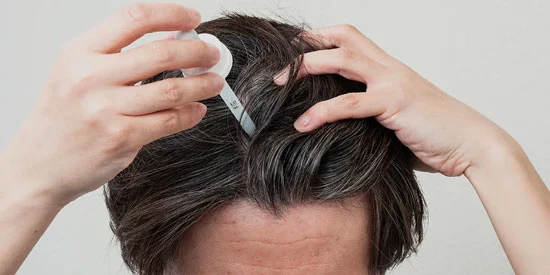Androgenetic alopecia, commonly known as male or female pattern baldness, affects millions of people worldwide. In recent years, minoxidil powder has emerged as a promising treatment option for this condition. This blog post explores the various applications of minoxidil powder in androgenetic alopecia treatment, discussing its effectiveness, potential benefits, and considerations for use. As we delve into this topic, we'll examine the science behind minoxidil powder, its role in hair growth stimulation, and how it's revolutionizing the approach to combating hair loss.

How does Minoxidil Powder work in treating Androgenetic Alopecia?
The mechanism of action of Minoxidil Powder
When applied to the skin, minoxidil powder fights androgenetic alopecia in more than one way. The main thing it does is widen blood vessels in the head so that more blood can get to hair follicles. Hair cells get more oxygen and food because of this better blood flow, which makes hair grow. The growth part of the hair cycle may also last longer and hair cells may get bigger if you use minoxidil powder. Prostaglandin E2 is a chemical that is known to help hair grow, and it may also be made more of. Early research shows that minoxidil powder may also boost growth factors and stem cells in the hair follicles, which makes hair grow back even faster. Scientists are still trying to figure out the exact molecular paths.
Absorption and effectiveness of Minoxidil Powder
The absorption and effectiveness of minoxidil powder in treating androgenetic alopecia depend on several factors. When applied to the scalp, minoxidil powder is absorbed through the skin and enters the bloodstream. The concentration of the minoxidil solution (typically 2% or 5%) affects its absorption rate and efficacy. In general, higher amounts work better, but they may also make side effects more likely. The effects of minoxidil powder can be different for each person. Some may see a lot of hair growth, while others may only see their hair loss slow down. How well the treatment works will depend on things like how long the hair loss has been going on, your age, and your general health. It is very important to use it consistently, as it usually takes a few months of regular use to see changes in hair growth and thickness that can be seen.
Potential side effects and precautions
Even though minoxidil powder is thought to be safe for most people, it's still important to know about the possible side effects and take the right safety measures. Some of the most common side effects are irritated, itchy, and dry skin. Some people may lose more hair in the first few weeks of treatment, but this is generally only temporary and goes away as new hair grows in. Absorption of minoxidil into the body can sometimes cause more dangerous side effects, like changes in blood pressure, a fast heartbeat, or weight gain. It's very important to carefully follow the dosage and application directions. Those with pre-existing cardiovascular conditions should consult a healthcare provider before using minoxidil powder. Pregnant or breastfeeding women should avoid using minoxidil, as its effects on fetal development are not well-studied. If any unusual or severe side effects occur, it's important to discontinue use and seek medical advice promptly.
What are the advantages of using Minoxidil Powder over other formulations?
Stability and shelf life of Minoxidil Powder
If you want your minoxidil to stay stable and last longer, using powder instead of other types is better. When it's in powder form, light, heat, and water are less likely to break it down. The product is now more stable, so it can be kept for longer without losing any of its usefulness. Powder forms are easier to store and move around than liquid forms because they don't take up as much space and are less likely to leak or spill. Minoxidil powder is stable, which also makes formulation choices wider because it is easy to mix into different vehicles, such as solutions, gels, or foams, depending on the specific product that is being made. Patients may be more likely to stick with their treatment if they can change their makeup to fit their needs.
Customization potential of Minoxidil Powder
One of the significant advantages of minoxidil powder is its high customization potential. Unlike pre-formulated solutions, minoxidil powder allows for tailored concentrations and combinations with other active ingredients. Because of this, healthcare professionals and compounding pharmacists can make unique formulas that meet the needs of each patient. For example, minoxidil powder can be mixed with other substances that help hair grow, like finasteride, biotin, or saw palmetto extract, to make a more complete treatment plan. Being able to change concentrations also lets you slowly raise the strength, which can help patients who may not be able to handle bigger doses at first. It is also easier to add minoxidil to different transport systems, such as liposomes or nanoparticles, when it is in powder form. This could make it work better and have fewer side effects.
Cost-effectiveness and accessibility of Minoxidil Powder
Minoxidil powder presents a cost-effective and accessible option for treating androgenetic alopecia. When compared to liquid forms, powders are usually cheaper to make, store, and ship. In this case, prices may go down for both sellers and buyers. A bigger group of people can afford to get treatment because minoxidil powder is less expensive. This could mean that more people can get better from treatments for hair loss. In addition, the powder form makes it possible to buy and store in bulk, which can be helpful for hospitals and shops. The ability to create custom formulations from minoxidil powder also means that patients can potentially save money by obtaining precisely the amount and concentration they need, rather than purchasing pre-formulated solutions that may contain excess product or inappropriate concentrations for their specific case.
How can Minoxidil Powder be incorporated into advanced hair loss treatments?
Combination therapies involving Minoxidil Powder
Minoxidil powder can be effectively incorporated into advanced hair loss treatments through combination therapies. One common approach is to combine minoxidil with oral finasteride, a DHT blocker, to target hair loss from multiple angles. It's possible that this method will work better than either treatment alone. Mixing minoxidil powder with topical anti-androgens or growth factors is another interesting idea that could make it work better. For example, some studies have shown that adding tretinoin to minoxidil formulations makes it more efficient and easier for the body to absorb. In some advanced methods, platelet-rich plasma (PRP) treatments also include minoxidil powder. The growth factors in PRP may work together with minoxidil to make hair grow faster. Because minoxidil powder can be used in many different ways, these combination medicines make it possible to make treatment plans that are specific to the different types of androgenetic alopecia.
Novel delivery systems for Minoxidil Powder
There is a lot of work being done on new ways to give minoxidil powder as part of cutting edge hair loss treatments. One new idea that can help minoxidil get deeper into the scalp and stay there longer is delivery ways based on nanoparticles. This minoxidil can be made to slowly leak out of these nanoparticles over time. This might help it work better and need to be used less often. One other option is to use microneedle patches or other devices that can get the minoxidil powder right into the skin without having to go through the stratum corneum layer. This way could help with taking it in and lowering the effects that have an effect on the whole body. It's also being thought about whether minoxidil powder could be put into hydrogels or other smart delivery systems that can respond to certain signals in the scalp. This would make it possible to release the active ingredient exactly and precisely.
Future prospects and ongoing research
It looks like minoxidil powder will be utilized in superior hair misfortune medications in the future. We are learning unused ways to make and utilize the pharmaceutical. It's a great thought to put minoxidil powder on your confront since it has chemicals that offer assistance it work in your hair. This might make it work superior. Three-dimensional prints of minoxidil powder are being utilized to offer assistance hair cells develop back as another strategy. This may alter the way individuals who are losing a parcel of hair are taken care of in a huge way. Minoxidil powder seem moreover be utilized in stem cell-based hair regrowth medications, which is an curiously thought. New hair shafts might do superior if they are invigorated and kept lively. As we learn more around the chemicals that make hair develop and drop out, minoxidil powder will likely be utilized in inventive unused ways. This implies it's likely to offer assistance treat androgenetic alopecia and other sorts of hair misfortune indeed more.
Conclusion
Minoxidil powder has emerged as a versatile and effective tool in the treatment of androgenetic alopecia. Its mechanism of action, combined with its stability, customization potential, and cost-effectiveness, makes it a valuable asset in both traditional and advanced hair loss therapies. As research continues to uncover new applications and delivery methods, the role of minoxidil powder in hair loss treatment is likely to expand further. While it's important to consider potential side effects and use the product as directed, minoxidil powder offers hope to millions suffering from hair loss, paving the way for more personalized and effective treatment strategies in the future.
Xi'an Salis Biological Co., Ltd., established in 2023, is at the forefront of developing high-quality biopharmaceuticals, including minoxidil powder. With a commitment to innovation and quality, Salis offers a range of APIs and custom solutions for various pharmaceutical needs. The company's state-of-the-art facilities and adherence to international quality standards ensure the production of superior minoxidil powder and other products. For more information or inquiries, please contact us at lea_slsbio@163.com,WhatsApp+86 13193326505.

FAQ
Q: How long does it take to see results from using minoxidil powder?
A: Results typically begin to appear after 3-6 months of consistent use, with maximum benefits often seen after 12 months.
Q: Can minoxidil powder be used by both men and women?
A: Yes, minoxidil powder is FDA-approved for use in both men and women for treating androgenetic alopecia.
Q: Are there any contraindications for using minoxidil powder?
A: Minoxidil should not be used by pregnant or breastfeeding women, and those with scalp conditions or cardiovascular issues should consult a doctor before use.
Q: How is minoxidil powder typically applied?
A: Minoxidil powder is usually dissolved in a solution and applied directly to the scalp twice daily, following the specific instructions provided with the product.
Q: Can minoxidil powder regrow hair on a completely bald scalp?
A: Minoxidil is most effective in areas where hair loss is recent and some hair follicles are still active. It may not be effective on completely bald areas.
References
1. Rossi A, et al. (2016). Minoxidil use in dermatology, side effects and recent patents. Recent Patents on Drug Delivery & Formulation, 10(1), 18-27.
2. Messenger AG, Rundegren J. (2004). Minoxidil: mechanisms of action on hair growth. British Journal of Dermatology, 150(2), 186-194.
3. Badri T, et al. (2021). Minoxidil. In: StatPearls [Internet]. Treasure Island (FL): StatPearls Publishing.
4. Suchonwanit P, et al. (2019). A randomized, investigator-blinded, controlled, split-scalp study of the efficacy and safety of a 1550-nm fractional erbium-glass laser, used in combination with topical 5% minoxidil versus 5% minoxidil alone, for the treatment of androgenetic alopecia. Lasers in Medical Science, 34(9), 1857-1864.
5. Varothai S, Bergfeld WF. (2014). Androgenetic alopecia: an evidence-based treatment update. American Journal of Clinical Dermatology, 15(3), 217-230.
6. Gupta AK, Charrette A. (2015). Topical Minoxidil: Systematic Review and Meta-Analysis of Its Efficacy in Androgenetic Alopecia. Skinmed, 13(3), 185-189.

